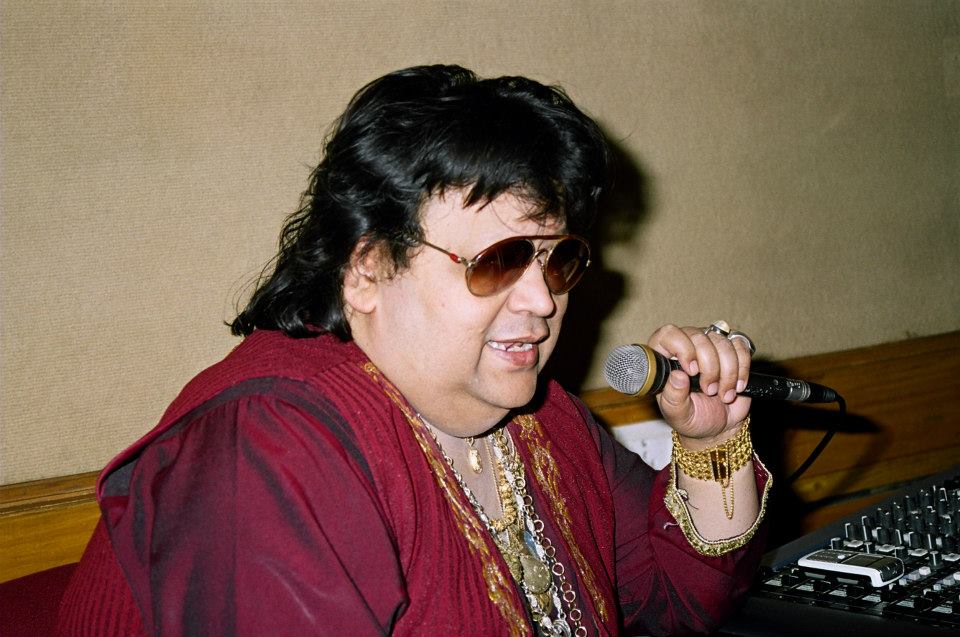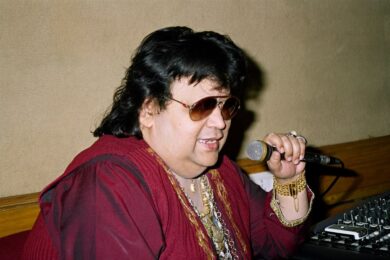Draped in his signature gold chains, velvet jacket, and glittering bracelets, Bollywood’s flamboyant disco king Bappi Lahiri would have been basking in the limelight of his 73rd birthday this week. Born in Jalpaiguri, West Bengal, the prolific composer who electrified 80s India with his disco-infused anthems died on 15 February 2022, leaving behind a legacy that democratised music by bringing Western beats to Indian streets – sounds previously only accessible to the elite – and reshaped the country’s musical landscape by inspiring new generations of Indian electronic artists.
Lahiri discovered disco for the first time in 1979 at a club in Chicago listening to Saturday Night Fever, an experience that would change the course of Bollywood music forever. With the electronic high hats of ‘Jimmy Jimmy” and the disco funk of ‘Jawani Janeman’, Lahiri emerged as one of India’s first pioneers of sample culture, helping to spearhead cultural globalisation. He inspired Bollywood contemporaries like Charanjit Singh to experiment with the TB-303 and TR-808 that powered the creation of the acid-soaked 1982 cult classic ‘Ten Ragas To A Disco Beat’.
Affectionately known as Bappi ‘da’ (meaning ‘brother’ in Bengali), he transported hearts and minds to another dimension with his music, becoming a household name not just across the Indian subcontinent, but also among the UK’s South Asian diaspora in the 80s. Racism was at an all-time high in Thatcher’s Britain and fascist, anti-immigrant hostility still surged – the echoes of Enoch Powell’s Rivers of Blood speech had not died away
Bollywood gave Brit-Asian communities a sense of belonging in the face of all that. Everyone went out and bought video cassette recorders so they could rent Bollywood films and tape TV shows like Network East that featured bhangra bands like Alaap and singers such as Nusrat Fateh Ali Khan and Gurdas Maan.
As a kid, my jaw dropped to numbers like ‘I Am A Disco Dancer’ and the ‘Video Killed The Radio Star’-sampling ‘Auva Auva Koi Yahan Nache Nache’. And as I began to explore this glitzy synth-soaked sound of Bollywood disco through a Brit Asian lens, I suddenly felt not only proud of my Indian roots but empowered to give the middle finger to the racists.
Music became a liberating force for the second generation South Asian diaspora and by the early 90s we were already buying albums by the likes of Fun-da-Mental and going to bhangra ‘daytimers’ – underground raves where DJs mashed up Bollywood disco with bhangra, R&B and hip-hop.
Artist M.I.A., who grew up on Bollywood disco in Sri Lanka, later paid homage to Lahiri with an autobiographical rework of ‘Jimmy’, while Indian artist DJ Harry Anand kicked off a remix wave around Lahiri’s 1981 classic ‘Thoda Resham Lagta Hai’, popularising the sampled hook (“Kaliyon ka chaman tab banta hai”) in the aftermath of DJ Quik’s unlicensed use of the track in Truth Hurts’ ‘Addictive’ – a move that led to a successful lawsuit by Lahiri. Back in India, Lahiri has continued to inspire new generations of artists. DJs like Suggahunny blend Bollywood with breaks and electronica, most notably in her live Rickshaw DJ set featuring remixes of retro tracks. Similarly, DJ Nida has paid tribute with a set featuring Lahiri remixes of tracks like ‘Hari Om Hari Om’. Many others cite him as a key influence, reimagining classics such as ‘Habiba’, ‘Disco Dancer’, and tracks like this MadStarBase remix of ‘Mausam Hai Gaane Ka’.
This new wave of emerging artists – both across the Indian subcontinent and within the South Asian diaspora – is living proof of Lahiri’s enduring legacy. He brought disco to the Indian mainstream with infectious energy, producing 180 songs for 35 films at his peak in 1986 and earning a place in the Guinness Book of Records. Open about borrowing tunes in an era when it was seen as inspiration rather than plagiarism, Bappi Da effectively introduced the concept of sampling to India, sparking a remix culture that continues to influence producers and DJs everywhere. Here’s a look at some of the tracks that cement his lasting impact.
M.I.A. – ‘Jimmy’
M.I.A. has described her version of ‘Jimmy’ as an autobiographical rework rooted in childhood memories of dancing to the original Bollywood disco hit in Sri Lanka. True to style, she layers that nostalgia with pointed political commentary: the lyrics reference conflict zones and “genocide tours,” drawing on her own encounters with journalists reporting mass atrocities. Her ‘Jimmy’ becomes an ambiguous, unreliable, possibly toxic figure worlds apart from the straightforward…




